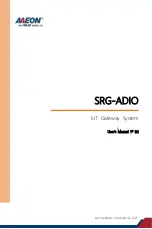
Prestige 662HW Series User’s Guide
15-4
Introduction to IPSec
15.3.1 Transport Mode
Transport
mode is used to protect upper layer protocols and only affects the data in the IP packet. In
Transport
mode, the IP packet contains the security protocol (
AH
or
ESP
) located after the original
IP header and options, but before any upper layer protocols contained in the packet (such as TCP and
UDP).
With
ESP,
protection is applied only to the upper layer protocols contained in the packet. The IP
header information and options are not used in the authentication process. Therefore, the originating IP
address cannot be verified for integrity against the data.
With the use of
AH
as the security protocol, protection is extended forward into the IP header to verify
the integrity of the entire packet by use of portions of the original IP header in the hashing process.
15.3.2 Tunnel Mode
Tunnel
mode encapsulates the entire IP packet to transmit it securely. A
Tunnel
mode is required for
gateway services to provide access to internal systems.
Tunnel
mode is fundamentally an IP tunnel
with authentication and encryption. This is the most common mode of operation.
Tunnel
mode is
required for gateway to gateway and host to gateway communications.
Tunnel
mode communications
have two sets of IP headers:
Outside header
: The outside IP header contains the destination IP address of the VPN
gateway.
Inside header
: The inside IP header contains the destination IP address of the final system
behind the VPN gateway. The security protocol appears after the outer IP header and before
the inside IP header.
15.4 IPSec and NAT
Read this section if you are running IPSec on a host computer behind the Prestige.
NAT is incompatible with the
AH
protocol in both
Transport
and
Tunnel
mode. An IPSec VPN
using the
AH
protocol digitally signs the outbound packet, both data payload and headers, with a hash
value appended to the packet. When using
AH
protocol, packet contents (the data payload) are not
encrypted.
A NAT device in between the IPSec endpoints will rewrite either the source or destination address
with one of its own choosing. The VPN device at the receiving end will verify the integrity of the
incoming packet by computing its own hash value, and complain that the hash value appended to the
received packet doesn't match. The VPN device at the receiving end doesn't know about the NAT in
the middle, so it assumes that the data has been maliciously altered.
IPSec using
ESP
in
Tunnel
mode encapsulates the entire original packet (including headers) in a new
IP packet. The new IP packet's source address is the outbound address of the sending VPN gateway,
and its destination address is the inbound address of the VPN device at the receiving end. When using
ESP
protocol with authentication, the packet contents (in this case, the entire original packet) are
encrypted. The encrypted contents, but not the new headers, are signed with a hash value appended to
the packet.
Tunnel
mode
ESP
with authentication is compatible with NAT because integrity checks are
performed over the combination of the "original header plus original payload," which is unchanged by
a NAT device.
Summary of Contents for Prestige 662HW Series
Page 26: ......
Page 28: ......
Page 36: ......
Page 54: ......
Page 56: ......
Page 64: ......
Page 84: ......
Page 100: ......
Page 116: ......
Page 128: ......
Page 150: ......
Page 154: ......
Page 162: ......
Page 168: ......
Page 194: ......
Page 196: ......
Page 200: ......
Page 208: ......
Page 214: ......
Page 216: ......
Page 230: ......
Page 242: ......
Page 244: ......
Page 252: ......
Page 258: ......
Page 262: ......
Page 266: ......
Page 272: ......
Page 286: ......
Page 290: ......
Page 310: ......
Page 328: ......
Page 352: ......
Page 358: ......
Page 362: ......
Page 374: ......
Page 376: ......
Page 394: ......
Page 398: ......
Page 400: ......
Page 410: ......
Page 444: ......
Page 452: ......
















































